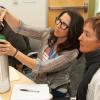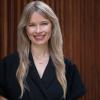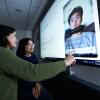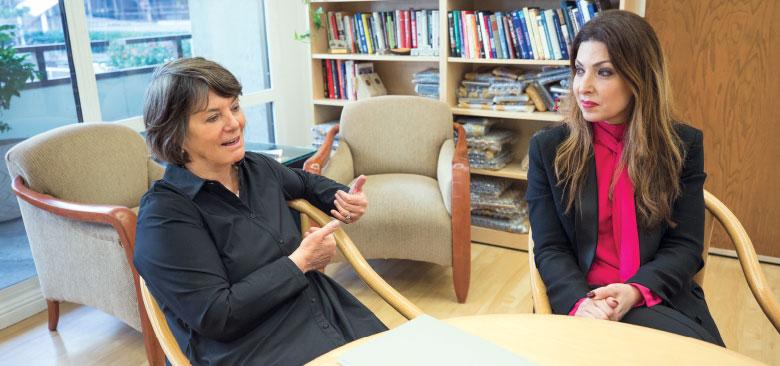
Dean Catherine Gilliss with Tina Mammone (photos by Elisabeth Fall)
Reinvigorated Partnership Strengthens Patient Care, Research and Education
In 2013, while she was director of clinical operations at what is now UCSF Helen Diller Medical Center at Parnassus Heights, Tina Mammone was also a PhD degree student, completing research on alarm fatigue at UC San Francisco School of Nursing. That work, led by the School’s Barbara Drew, would draw national attention, including articles in the San Francisco Chronicle and Wall Street Journal. Ultimately, it would be a contributing factor in the $25 million donation from David Mortara that created the School’s Center for Physiologic Research (CPR).
“What I found most valuable about being a medical center employee and PhD student was that I could align the best of both places: Use the School’s guidance and my knowledge and ability as a UCSF nurse to help realize meaningful research that changed clinical practice,” says Mammone. Now vice president and chief nursing officer of UCSF Health, she is co-leading a dynamic effort aimed at optimizing the advantages of tighter integration between the two organizations.
Catherine Gilliss is her partner in this effort. The dean of the School since September 2017 – as well as associate vice chancellor, nursing affairs for UCSF – Gilliss arrived with the experience and skills necessary to make the most of this renewed partnership. She was a faculty member and a department chair at the School in the 1990s, before leading both the Yale and Duke schools of nursing. Having earned a national reputation as a positive change agent during years of head-spinning change in the United States health care system, Gilliss is a true believer in more closely entwining the two institutions.
“There are many benefits in bringing together people who are fundamentally interested in practice with people fundamentally interested in education or research,” she says. “The more reality-oriented our faculty are, the greater our educational programs and our research efforts – and we believe that our research and subject matter knowledge can add to the quality of the health system.”
A Formal Agreement to Overcome Barriers
In theory, UCSF Health’s aim to achieve better care for individuals, better health for populations and slower growth in costs through improvements in care would seem an ideal complement to the School’s goals of producing knowledge and educating the next generation of advanced practice (AP) nurses.
But in practice, it’s not easy for academic medical centers and schools of nursing to align their distinct missions. Everything from simple logistics and cultural barriers that have grown over time through nonstop demands for change can conspire against such initiatives. Gilliss and Mammone are determined to overcome these challenges by creating a new model for the relationship between a chief nurse and a nursing school dean.
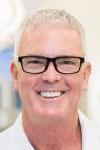 Mitchel Erickson As UCSF’s associate vice chancellor for nursing affairs – the first time a School dean has held such a position – Gilliss serves on high-level strategic and operational committees for UCSF Health and meets regularly with Mammone; Mitchel Erickson, director of advanced practice; and Daphne Stannard, director and chief nurse researcher at UCSF Health’s Institute for Nursing Excellence. “The meetings hold us accountable for moving forward on issues of joint concern and help us identify opportunities to work together,” says Gilliss.
Mitchel Erickson As UCSF’s associate vice chancellor for nursing affairs – the first time a School dean has held such a position – Gilliss serves on high-level strategic and operational committees for UCSF Health and meets regularly with Mammone; Mitchel Erickson, director of advanced practice; and Daphne Stannard, director and chief nurse researcher at UCSF Health’s Institute for Nursing Excellence. “The meetings hold us accountable for moving forward on issues of joint concern and help us identify opportunities to work together,” says Gilliss.
 Mammone with Daphne Stannard (right) As the associate dean for clinical affairs at the School – a newly created position – Mammone will be part of the School’s leadership team. She and Gilliss have begun exploring structural changes within the School that could better support clinical activities at UCSF Health, for which Mammone can offer high-level direction.
Mammone with Daphne Stannard (right) As the associate dean for clinical affairs at the School – a newly created position – Mammone will be part of the School’s leadership team. She and Gilliss have begun exploring structural changes within the School that could better support clinical activities at UCSF Health, for which Mammone can offer high-level direction.
The hope is to better align and address each other’s priorities wherever possible, which is why the two are carefully delineating their roles and responsibilities in writing, with input from School faculty and medical center nurses.
“An intentional and specific memorandum of agreement – a signature on paper – formalizes our relationship in a meaningful way, because you always hit bumps, and when you do, that document can guide you through the difficult moments,” says Gilliss.
Bringing More Science to the Bedside
Once they sign on the dotted line, Gilliss and Mammone must determine what innovations their tighter partnership can produce, be it joint research, the integration of faculty members and alumni into clinical work at UCSF Health, or refinement of the School’s educational programs.
Perhaps the lowest-hanging fruit involves building on a tradition of joint research, such as Mammone’s project on alarm fatigue. That specific work continues with the added advantage of close collaboration with the School’s newly established CPR. “We have to solve the problem of alarm fatigue, and the School has received a beautiful gift that makes research possible here that cannot be done in many other places,” says Mammone.
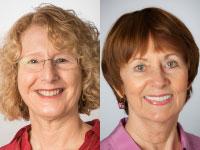 Linda Franck (left) and Kathleen Puntillo Another example involves the way, over a number of years, School faculty members Linda Franck and Kathleen Puntillo have worked closely with medical center colleagues to make UCSF a leader in family-centered care, palliative care research, and innovation in neonatal, pediatric and adult intensive care units (ICUs). Both professors point to how UCSF Benioff Children’s Hospitals and UCSF Helen Diller Medical Center have long-standing investments in partnering with families and fostering an environment that supports family engagement. In 2017, as members of an international expert panel sponsored by the Society of Critical Care Medicine, the two were co-authors of guidelines on family-centered care in the ICU, which were published in Critical Care Medicine.
Linda Franck (left) and Kathleen Puntillo Another example involves the way, over a number of years, School faculty members Linda Franck and Kathleen Puntillo have worked closely with medical center colleagues to make UCSF a leader in family-centered care, palliative care research, and innovation in neonatal, pediatric and adult intensive care units (ICUs). Both professors point to how UCSF Benioff Children’s Hospitals and UCSF Helen Diller Medical Center have long-standing investments in partnering with families and fostering an environment that supports family engagement. In 2017, as members of an international expert panel sponsored by the Society of Critical Care Medicine, the two were co-authors of guidelines on family-centered care in the ICU, which were published in Critical Care Medicine.
Such efforts are powerful, says Stannard, precisely because of the mix of perspectives. “The more people involved, the stronger the project,” she says. “The School of Nursing has real research and content expertise, and on the medical center side, we have deep experience in the operational aspects – in what’s actually possible and practical to do.”
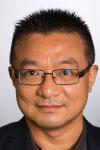 Xiao Hu She tells of a meeting she had with faculty member and biomedical engineer Xiao Hu about his research aimed at optimizing alarms connected to a neurological drain device. When they walked over to the ICU to see the process in real time, they spoke with a bedside ICU nurse whose input helped Hu better understand the actual “cognitive filtering” nurses do for themselves; in turn, Hu was able to refine his prototype.
Xiao Hu She tells of a meeting she had with faculty member and biomedical engineer Xiao Hu about his research aimed at optimizing alarms connected to a neurological drain device. When they walked over to the ICU to see the process in real time, they spoke with a bedside ICU nurse whose input helped Hu better understand the actual “cognitive filtering” nurses do for themselves; in turn, Hu was able to refine his prototype.
Stannard also believes the tighter integration can be a boon for her long-standing mission of infusing evidence-based care into everything nurses do at UCSF Health and helping them critically appraise their practice.
“Using the best available evidence is already mother’s milk in our organization,” she says. “It’s not uncommon for our nurses to ask: ‘What’s the evidence behind that?’” The reinvigorated partnership should deepen and spread that type of thinking.
Gilliss points to the School establishing a Doctor of Nursing Practice (DNP) degree program in 2017 as one potential avenue. Part of the goal of that program is to teach nurses how to use scientific knowledge in the service of improving care. Gilliss hopes that UCSF Medical Center nurses will enroll in the program. Others may benefit simply from the presence of DNP students completing projects at the hospital.
“Improving clinical outcomes is tied to the professional development of our nursing workforce, and the availability of the DNP program is a great avenue for that type of development,” says Mammone.
In addition, formalizing some relationships – including, perhaps, more medical center AP nurses becoming adjunct faculty at the School – could lead to more targeted teams to address clinical concerns and quality improvement. “I love getting bedside nurses involved in these types of activities,” says Stannard. She hopes, for example, to grow and codify intramural funding processes, in which funding is typically split between the School and the Department of Nursing’s Clinical InQuERI Council in support of what is often pilot research for larger projects.
“It’s all about putting together the right people at the right time,” says Stannard.
Meeting Patient Care Needs
Such efforts could become easier if more faculty members engage in clinical practice for UCSF Health, and, says Gilliss, “We are making headway on overcoming some of the traditional barriers to these types of faculty practice.”
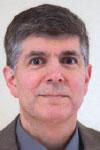 David Rein “It’s nice that the chancellor understands the health systems environment and the roles of the various schools so well,” says David Rein, the School’s associate dean for finance and administration, who formerly was the director of operations for UCSF Medical Group. “With several structural changes on the health system side, including the reduction of residency hours, there is a push to use more advanced practice nurses, with an emphasis on them working to the top of their license.”
David Rein “It’s nice that the chancellor understands the health systems environment and the roles of the various schools so well,” says David Rein, the School’s associate dean for finance and administration, who formerly was the director of operations for UCSF Medical Group. “With several structural changes on the health system side, including the reduction of residency hours, there is a push to use more advanced practice nurses, with an emphasis on them working to the top of their license.”
The advantages to both organizations could be significant. Consider that many AP nursing positions take weeks to fill. “We have faculty who are expert clinicians and who want the opportunity to practice here at UCSF,” says Gilliss.
But, she notes, the care at an academic medical center is highly specialized, and effective clinicians need a continued presence. Mammone agrees. “Things change fast here. For example, if you are not working with the EHR [electronic health record] every couple of days – if you’re not comfortable with our clinical documentation requirements – that aspect of the job alone can be very challenging. All nurses struggle with the cadence of change, but to organize a faculty practice in a place like this, we have to find the right fit for those who are interested and build an infrastructure for training them and getting them credentialed.”
“There are also ways we can help the faculty prepare to re-enter practice areas that match their research expertise,” says Gilliss. “Many are already working in primary care, and we will try to create opportunities for others, but we need to negotiate business arrangements that allow our faculty to be successful while delivering value and needed care.”
Shaping Educational Programs, Creating Pipelines Back and Forth
The advantages of getting faculty more involved in day-to-day practice go beyond filling clinical needs or enhancing research. Gilliss says that in-depth knowledge of the ways in which care is constantly changing in the real world can dramatically improve the School’s educational programs. “When our faculty are actively engaged in clinical practice, they are more aware of the needs of the practice environment and the knowledge needed by our graduates to be effective there,” she adds.
In addition to expanding faculty practice, Gilliss is exploring educational opportunities that benefit both institutions. She is putting together a committee of chief nurses from key clinical partners in the Bay Area to advise the School about the quality and content of its degree-based programs and other potential educational efforts. The ideas have already begun to flow.
“One area we are exploring is leadership development,” says Gilliss. “Having well-prepared middle managers is essential to running the organization and maintaining a talented workforce with high morale. We can be helpful to developing leadership capacity at UCSF in that space.”
In particular, Gilliss is interested in creating a leadership institute, so clinically focused nurses can complete continuing education requirements that advance their careers. Such an institute could build on existing School resources and expand them. Many of the degree programs already have organizational leadership components, and the School also has its much-praised master’s degree program in Healthcare Administration and Interprofessional Leadership (MS-HAIL). Gilliss, Mammone and the directors of MS-HAIL are exploring ways to modify the MS-HAIL curriculum, so clinical nurses can receive credit for academic advancement in their own fields. Specifically, they intend to create pathways to bridge that leadership degree program toward the DNP.
Perhaps most prominently, the DNP degree program has built out a strong leadership component, tailored to working nurses. “The DNP is an opportunity for advanced practice nurses that was not available a year ago, and I hope many of our nurses will take advantage, because the School’s graduates are always so well prepared,” says Mammone. “I see developing as many nurses as we can in-house as a key part of our succession planning.”
Stannard says she often suggests that nurses who go through the department’s Evidence-Based Practice Fellows program consider applying to one of the School’s master’s degree programs – and many do. “It’s a synergistic relationship, and we believe the more education our nurses have, the better,” says Stannard.
Mutual Respect Shortens the Distance Across the Quad
Of course, as with any blending of two large organizations, leadership compatibility can play a key role. Stannard is among those excited by the ways the burgeoning partnership between the organizations’ two leaders makes it easier to cross the physical (in the case of UCSF Helen Diller Medical Center) and metaphorical quad that separates the School and the health system.
Says Gilliss, “It’s really wonderful that I have the opportunity to work with a doctorally prepared chief nurse who understands the importance of science, and how she, her team and her educational partners can bring science to the bedside. Tina is the complete package.”
For her part, Mammone says, “I’m delighted that Catherine is here. She is what we’ve all been wanting and hoping for; we can change each other’s environments for the better, and I look forward to partnering any way we can.”

